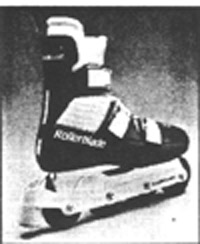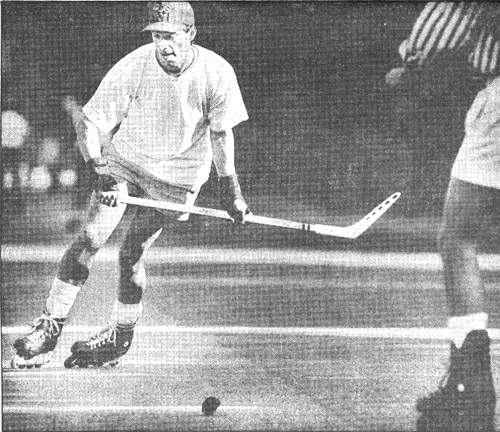 |
| San
Francisco Chronicle Feb. 22, 1990 |
 |
 Aided by a ramp, Greg Levien performs a high-jumping maneuver on inline skates |
Faster and sleeker than the
old models, in-line skates are taking the country by storm BY DAVID RUBIEN Hang on folks, the '90s Just might be the decade of the roller skate. I know, I know, you've heard it before. That's what everybody was saying in the 70s when, to motorists' chagrin, skates by the millions seemed to be taking over the national pavement. But now the ante's been upped, A new kind of roller skate is poised to cause a revolution in the sport, and motorist probably will be more aggravated than ever. Called in-line skates, the new designs feature a single row of thin wheels down the middle of the skate - much like the blade of an ice skate - as opposed to two rows of fat wheels on conventional roller skates. The sleek in-line skates take the sport into new dimensions of speed, maneuverability and ease, and they are rapidly eating into sales of conventional models. In the evolution of the roller skate, the metal clip-on key jobs that a lot of us used as kids were the horse-and-buggy of skates. When polyurethane wheels came along, provoking the boom in the '70s, skates entered the age of the reliable family car. The in-line skate, then, is like a turbo-charged Maserati. |
| "You can easily get up to 40 to
45 miles per hour on in-line skates - if you're going downhill" says David Miles, who
as president of the Outdoor Rollerskating Association of America is the coordinator for
most organized skating in the state. "On flat ground," says Miles, "the
average person could get up to 20 miles per hour." The bottom line is you have to
power the skate, and with inlines there's less friction; you need less energy to
move." Most skaters in the park are on in-lines - 65 percent to 70 percent, according to Miles - and the people not only seem faster, but more graceful and poised. There will be more of them, too, because in-line sales are blazing. Lee Cole, owner of Skates on Haight in San Francisco, which rents and sells skates, says 75 percent of his roller skate sales comprise inlines. For a chance to try out in-line skates for free, visit the Chronicle Great Outdoors Adventure Fair at the San Francisco Concourse on March 2-4. Rollerblade, Inc., the largest manufacturer of inline skates, will have a demo van with instructors ready to show you the ins and outs of the sport. |
 Inline skates have a single
line of wheels down the middle of the sole Inline skates have a single
line of wheels down the middle of the sole |
 Mike Riddle zooms down the slalom
course on JFK Drive in Golden Gate Park Mike Riddle zooms down the slalom
course on JFK Drive in Golden Gate Park |
The standard in-line skate design
features a lace-up boot attached to a lightweight aluminum or fiberglass frame with four
wheels made of polyurethane or a similar polymer. What first impresses you upon trying on
the skates is how stable they are. Although they look like ice skates and rely on the same motion for propulsion, there's no annoying ankle wobble. And unlike conventional roller skates, "you don't always feel like you're falling backwards," says Miles. In-lines also roll right over the bumps, cracks and rocks that confound centional skates. |
| The only problem that seems to haunt inlines is their braking system. With toe breaks, conventional skates can stop on a dime; in-lines have a rubber stopper at the heel that you have to jam down on while you drag the back skate - an awkward motion. There are other ways of stopping too, such as the T-stop and the quick 180 degree sweep, but they require practice. |
| Inline braking deficiency makes Miles wary of using the
skates down a steep hill. "If there's a kid or a car coming out, I need to know that
I can stop instantly," he says. Nothing, however, has been putting, the brakes on the
roll of consumers into the in-line market. Cole says his skate sales have tripled in the past six months, and a spokesperson at Rollerblade, Inc. of Eden Prairie, Minn., .says sales have been doubling every year. The National Sporting Goods Association reports that nearly 20 million people rollerskate every year, which amounts to a huge potential market for in-lines. What's to say the industry is not merely starting another fad in the |
 Borrowing from ice hockey, an inline skater pushes a puck down JFK Drive in Golden Gate Park |
| face of one that will fizzle out after a
few years just as the conventiona skate boom died with the'70's The answer is physical
fitness. The pushing-out-from-the-side skating motion used with inlines works the same muscles as cycling, ice skating and cross-country skiing In other words, it's a perfect way to cross-train. In this respect, Europe is way ahead of the United States, particularly the Netherlands where thousands of professional cross-country skiers and cyclists compete in a "skeelering" circuit in the summer. Races go up to 200 kilometers and skaters attain sprinting speeds of 45 miIes per hour. Competitive roller-skating in this country is in its infancy, but many top proud amateur athletes have been using in-lines as training tools including members of the 7Eleven and Reebok cycling. teams and the U.S.Ski Team. The skates also have caught the fancy of several professional hockey players. It was a pro hockey player, in fact, who first put in-line skates on the market In the late 1980's, Bloomington, Minn. native Scott Olson, then 21, left a promising hockey career to improve a type of inline skate manufactured in Los Angeles. In a few years he had created the basic modern in-line skate, and formed Rollerblade Inc. Since bought out by investors, Olson. has formed a new company, Switch-it, which soon will release a boot that can be attached with either an ice skate blade or an in-line chassis. Other inline mamufacturers areBauer Roller Derby, Ultra Wheels and Zaenstra, but rollerblade is by far the market leader, with 75 percent of all sales. "Rollerblade is like the Schwinn bicycle of roller skates," says Cole, who rents out the brand almost exclusively. Miles agrees, saying "No one makes a better skate - except Zaenstra." Popular in Europe, Zaenstra represents the high end of the market, with pairs going for $350. Zaenstras have five wheels in the frame instead of four and are faster, but they sacrifice maneuverability. Roller Derby makes the cheapest in-line skate, a children's model for $50 a pair, available at stores such as Toys R Us and K-Mart. Rollerblades range from $90 to $250. On average, in-lines are about 10 percent more expensive than conventional roller skates. According to Cole and Miles, competition is key to the long term survival of roller-skating, whether in-line or conventional. "We have to develop a competitive framework, then turn it into an Olympic sport," says Cole, who sponsors local races. "The sport will remain a fad until that framework exists." Roller-skating is scheduled to be an exhibition sport at the 1992 Olympics. At the local level there were four major races that attracted 400 competitors last spring and summer. Events included l00-meter to 500-meter races, high jump, long jump, downhill slalom and freestyle dance. There also was the Los Angeles to San Francisco Skate Against Crack and Violence, which will be repeated in the opposite direction on March 19, with skaters covering 100 miles per day on back roads. (See accompanying box for the 1990 racing schedule.) Miles has been involved with organized skating since 1980, and with the arrival of in-lines, he believes the sport is ready to get some respect. "We have to have some way to pass this on to the kids," he say_. "People say it's just a fad - that skating will be gone soon - but skating has been documented for years and years. We want to make some noise. |